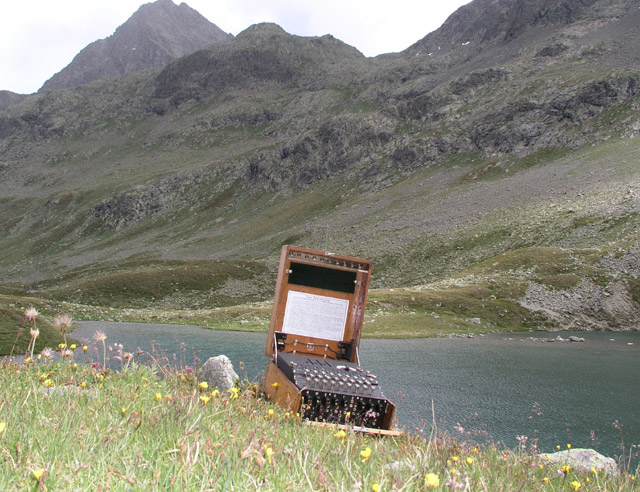
POST-MORTEM AUTOPSY of a GERMAN ENIGMA
http://w1tp.com/enigma
Tom Perera: Curator
Copyright (c) 2011, Tom Perera
At the end of WW-II the German military needed to dispose of their secret
Enigma Cipher machines and other instruments of war. They were scattered all
over Europe and could not be brought together for mass destruction.
Although the German soldiers were instructed to use explosives placed and
detonated inside the Enigma cases, many chose an easier (and safer)
alternative and dumped them into nearby lakes. Simetimes they had time to
try to damage them with tools that were nearby and sometimes they just threw
them into a convenient lake.
This website describes a German WW-II 4-rotor Marine Enigma that was recovered
in 2010 after remaining underwater in a lake for over 65 years and attempts
to reconstruct the murder scene and identify the cause of death.
Enigmas were abandonned all over Europe and it was up to roving groups of soldiers to find and destroy them.
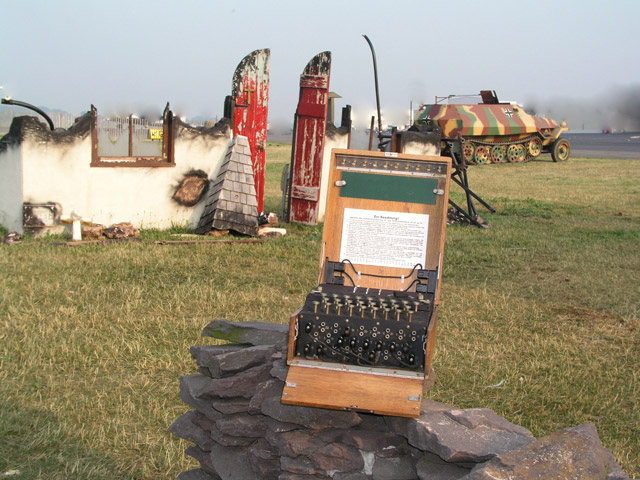

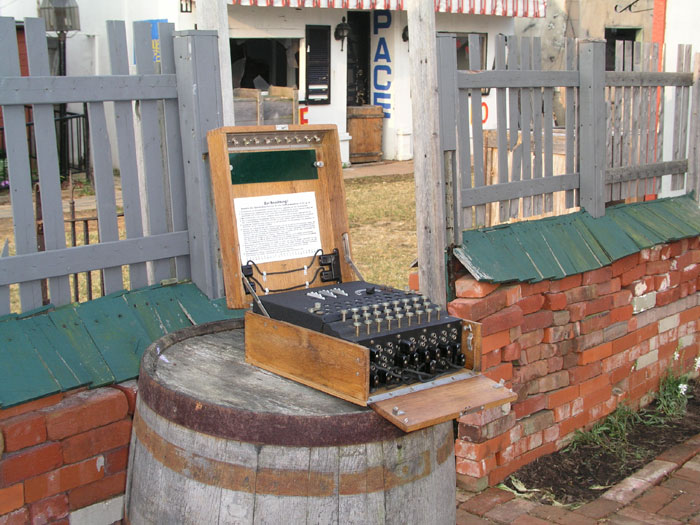
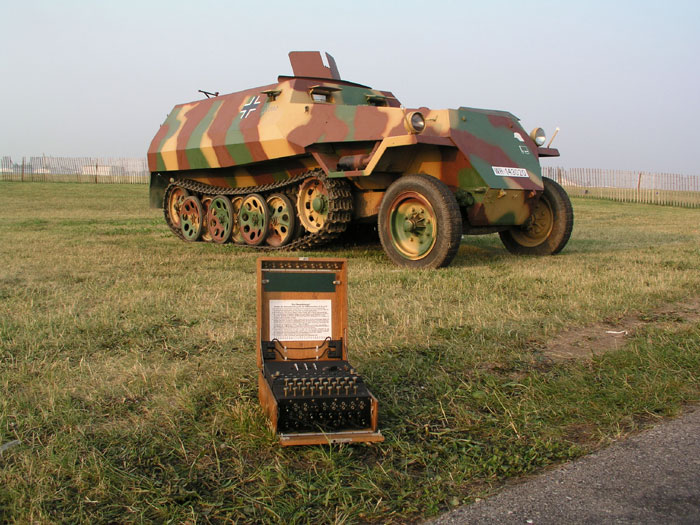
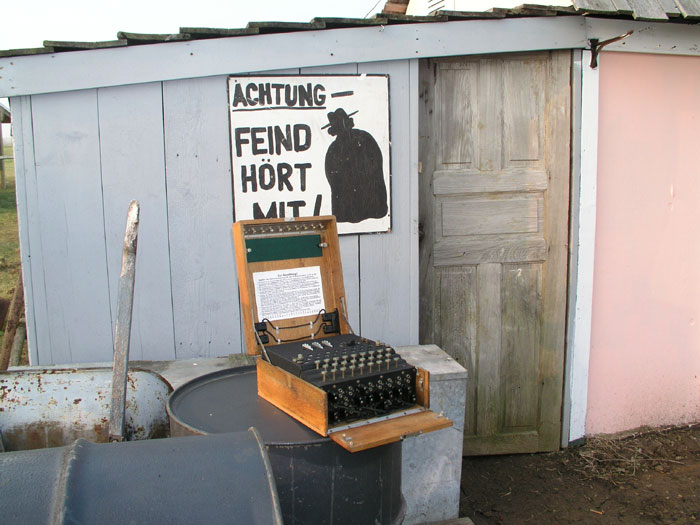
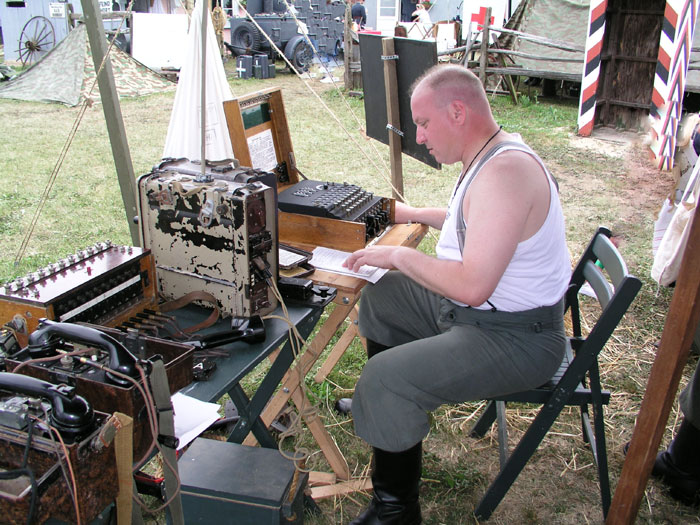
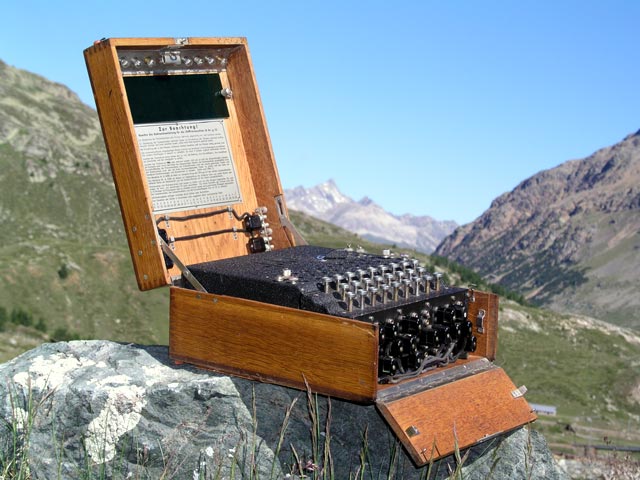
DIVING FOR ENIGMAS
Of course, some Enigmas went down to the bottom of the ocean in German ships and submarines. They were typically not severaly damaged but 65 years of immersion in salt water has severaly corroded most of the metal parts. Here are two Enigmas that were recovered from a German submarine: U-85. These pictures are presented with the permission of the divers who recovered the Enigmas and Dr. David Hamer on whose website you can find more photos of these machines: http://home.comcast.net/~dhhamer/u-85gal.htm
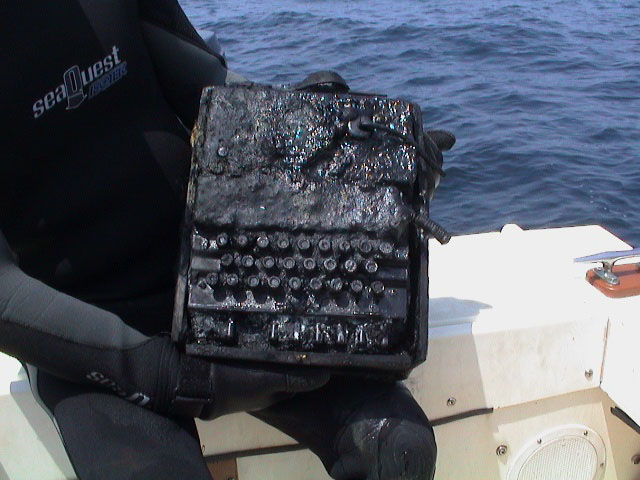
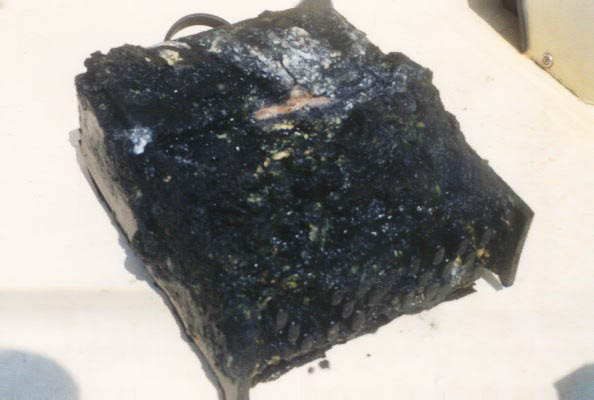
THE SCENE OF THE CRIME:
The German government does not want people diving in lakes where live ammunition poses a danger to the divers and onlookers so many of the lakes in Germany remain closed to divers and therefore unexplored.
This Enigma machine was located in a privately-owned lake in northern Germany
where government restrictions do not apply. Local residents had heard stories
about equipment being dumped into the lake and it seemed worthwhile to check
the lake with underwater metal detectors.


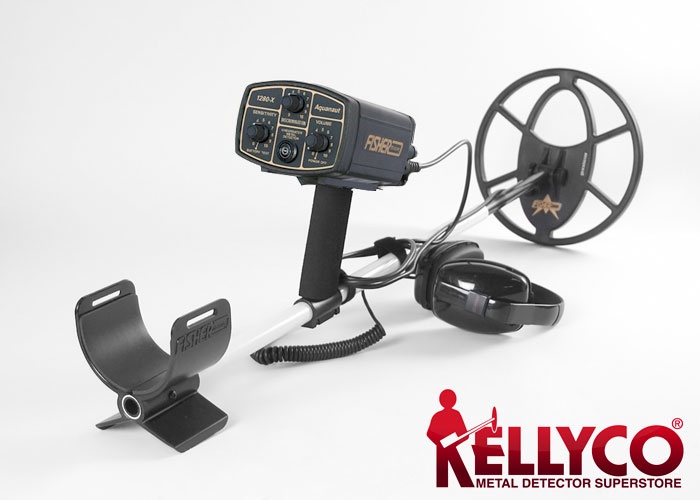
UNDERWATER METAL DETECTORS
Metal detectors for use underwater need to be capable of withstanding considerable pressure while still sending and receiving electronic pulses that bounce off metal objects and report them by making sounds in a set of headphones worn by a diver. This picture of the Fischer 1280x metal detector used to locate the Enigma comes from the Kellycodetectors.com website.The Fischer 1280x is a low frequency detector that allows some discrimination between ferrous and non-ferrous metals. Pulse-induction detectors are more stable underwater but do not allow any discrimination between metals.
Clearly the person who destroyed this Enigma never expected it to be recovered.
Not only did it remain in the water for over 65 years but it gradually sank
into the muddy bottom of the lake. If it had not been for a sensitive metal
locator and some persistent hunting, it might never have been recovered.
Even with a good metal detector that discriminates well between metals, many
signals are heard in the headphones and it is usually wise to dig each metal
object out of the mud rather than relying on the discrimination of the
detector to eliminate unwanted objects.
Here are some photographs of the metal-bearing objects that were found during
the dives that eventually brought the Enigma back to the surface.
PARTS OF A SECRET TORPEDO
Some of these pieces are parts of a secret acoustic torpedo: "ZAUKONIG". It
was powered by a 55 hp electric motor and had a speed of 24 knots and a range
of 5.7 km. It had a very sensitive acoustic homing capability but in bad
weather it detonated either early or late and it was only sensitive to ships
traveling at 15 knots! Allied skippers would set their speed either above or
below 15 knots knowing that they would be safer. The Allied forces also
developed anti-GNAT devices that made noises and distracted acoustic homing
torpedos: (See: http://www.one35th.com/seehund/sh_armament.htm for more
information on the torpedo.) It is unclear why parts of a secret torpedo were
found in an inland fresh water lake and that may remain an unsolved mystery.

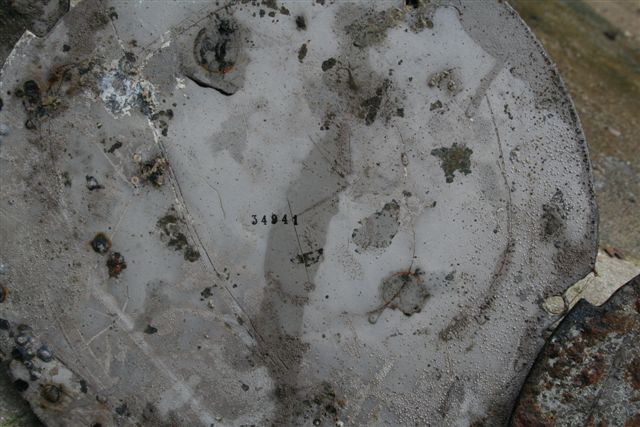
PARTS OF GERMAN FIELD RADIOS
Other recovered objects are pieces of fairly common German WW-II field radios.

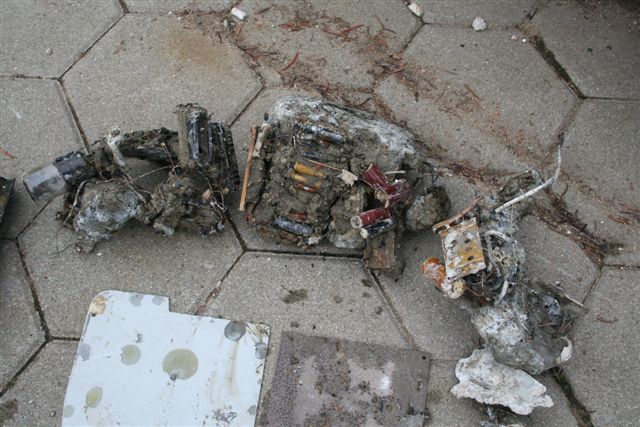
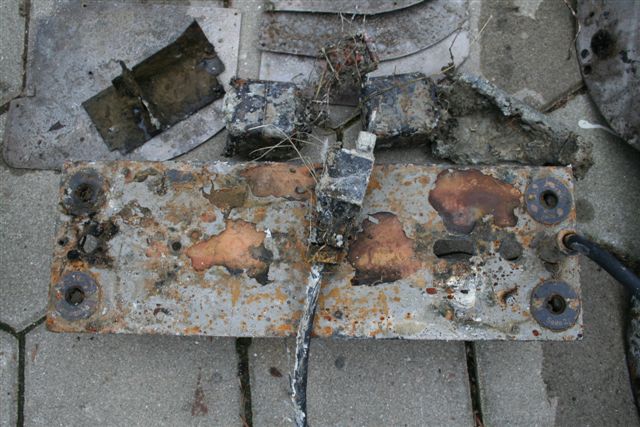
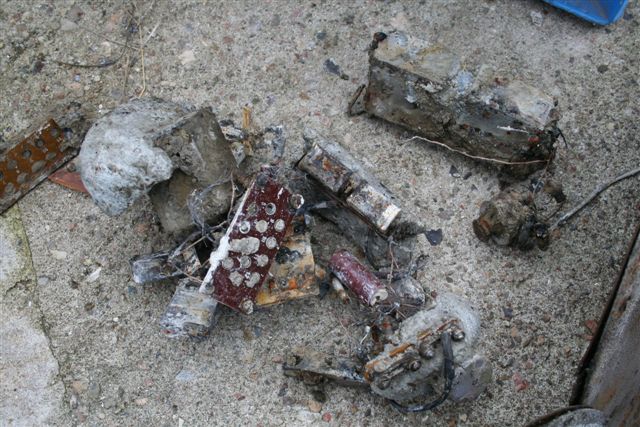
THE ENIGMA
And finally, the Enigma surfaces after 65 years underwater:
At first, it is very hard to recognize it as an Enigma but even a rapid
inspection reveals that it is a 4-rotor Enigma because there are 4 slots for
the rotor thumb wheels. 4-rotor Enigmas were exclusively used by the German
navy (the Kriegsmarine).
One of the puzzles presented by the discovery of this Navy Enigma is why it
was found in an inland lake far away from the sea.
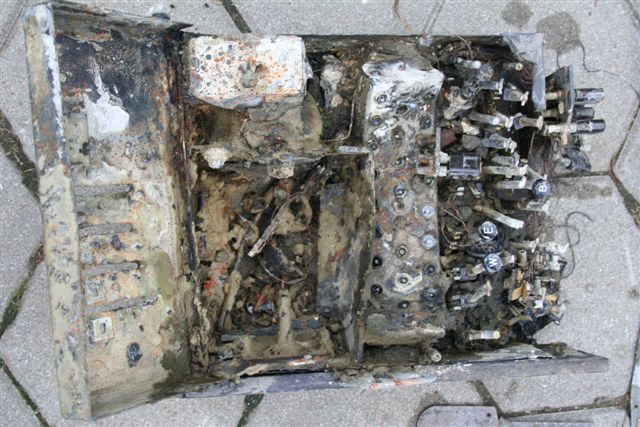
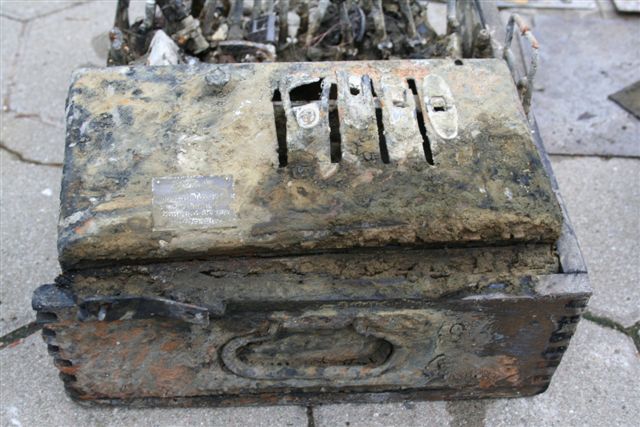
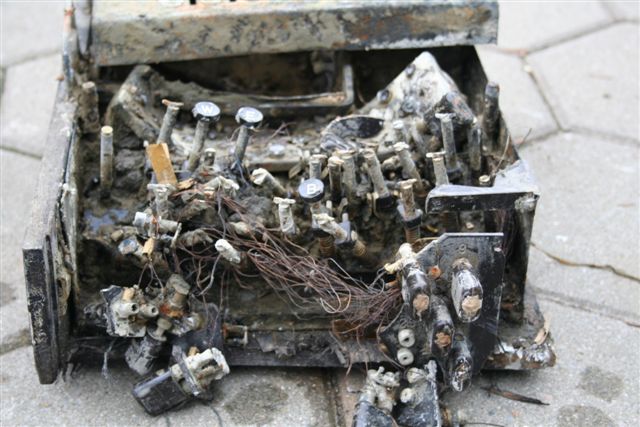
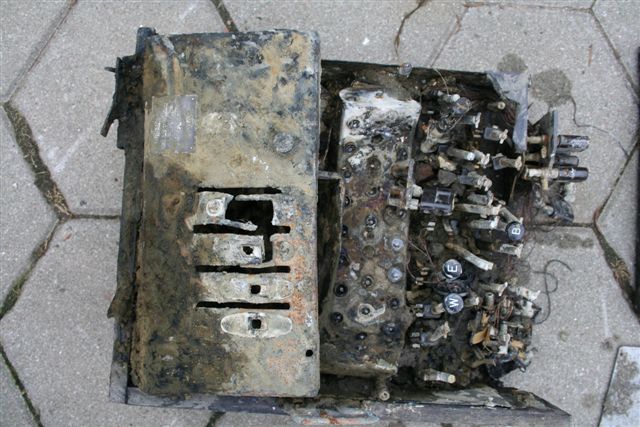
CLEANING THE ENIGMA
Some of the mud is removed to show more of the Enigma and to eliminate the
moisture trapped in the mud that would cause further rusting and
corrosion. Warm water is applied to loosen and dissolve the mud and then it
is allowed to dry.
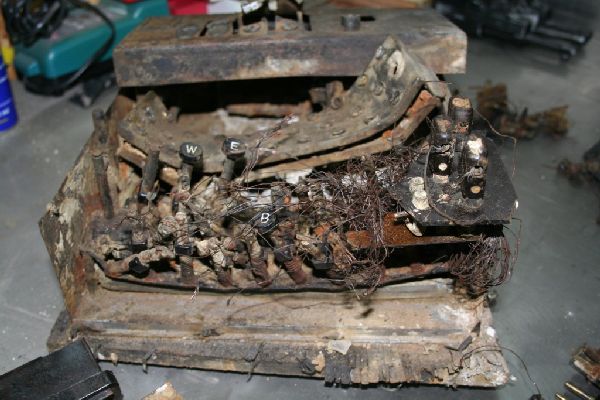
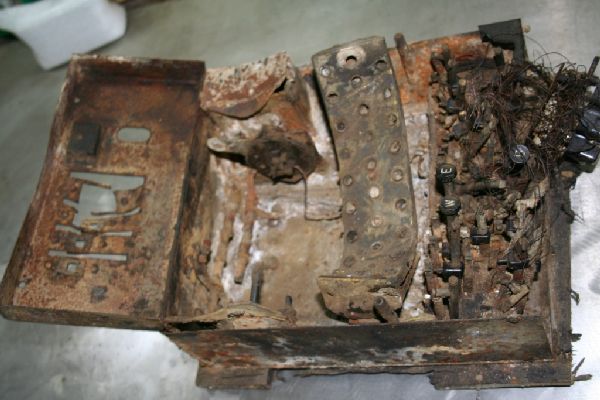
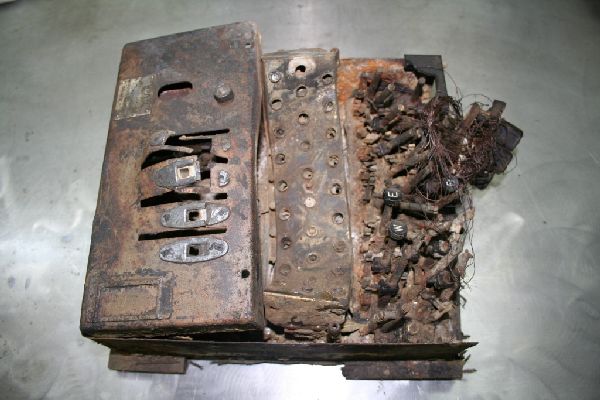
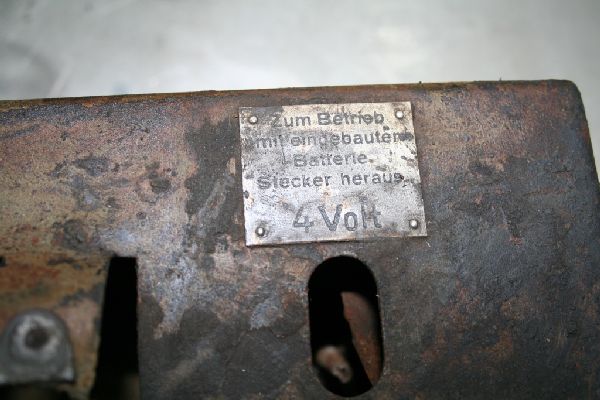
The large number of small parts found near the Enigma suggest that there might have been a second Enigma in the area. This was confirmed when a second 4- slot metal rotor cover was recovered. Additional diving is planned.
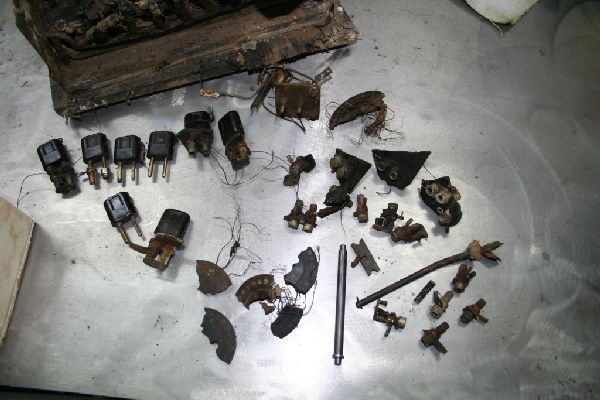
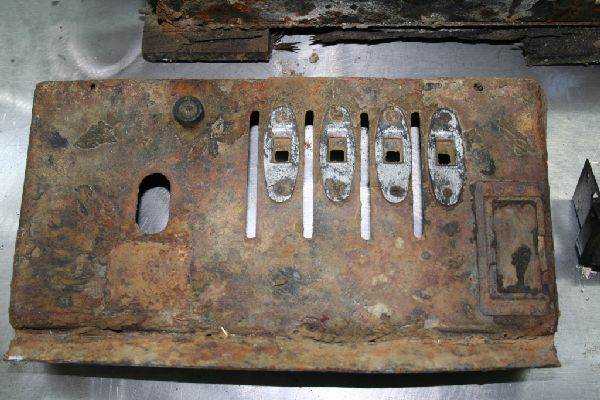
LOSS OF THE METAL DETECTOR
Unfortunately, the visibility at the bottom of the lake is so bad that the metal locator could not be found after the Enigma parts were recovered. A good deal of time was spent hunting for the metal locator but it was never found. A new metal detector has been purchased and it is hoped that it will not only locate additional Enigma parts but also that it will locate the original metal detector.
RECONSTRUCTION OF THE CRIME SCENE
Now that the remains have been recovered and very gently and carefully cleaned, it is time to try to reconstruct the crime and determine the cause of death. Then the remains must be stabilized to prevent further deterioration:DETERMINING THE CAUSE OF DEATH
As with any autopsy, the main goal is to determine the cause of death. A close
look at the Enigma reveals major damage from a crushing impact applied to the
top of the lamp panel as well as many other less dramatic impacts.
The damage can best be assessed by comparing it with an undamaged Enigma of the same model. This is an undamaged Marine 4-rotor M4 Enigma:

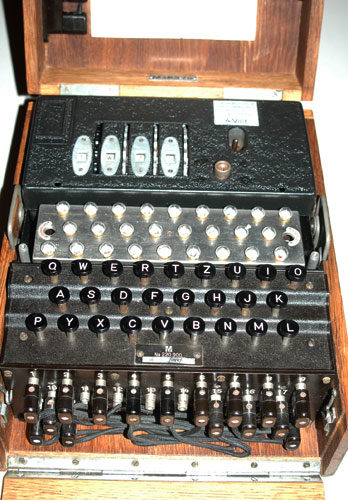
The damage is obvious after this comparison. The lamp panel cover has been
removed and the center of the lamp panel has been depressed an average of 3 cm
below the ends of the panel by some kind of vertical force.
The lamp panel cover must be removed in order to gain access to the rotor
mechanism so at least a small amount of time and thought must have preceded
the fatal blow to the lamp panel itself. The following photographs show
various views of this damage.
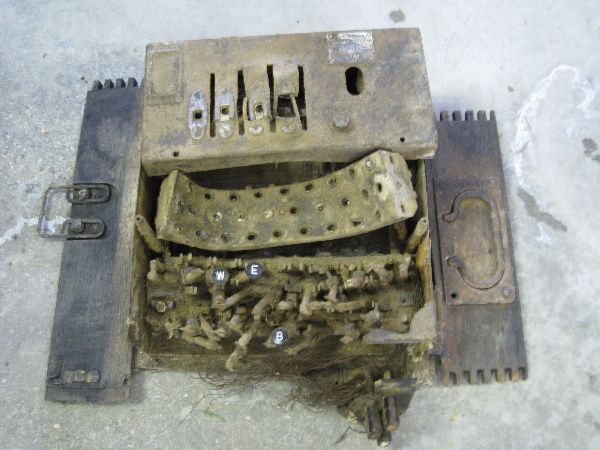
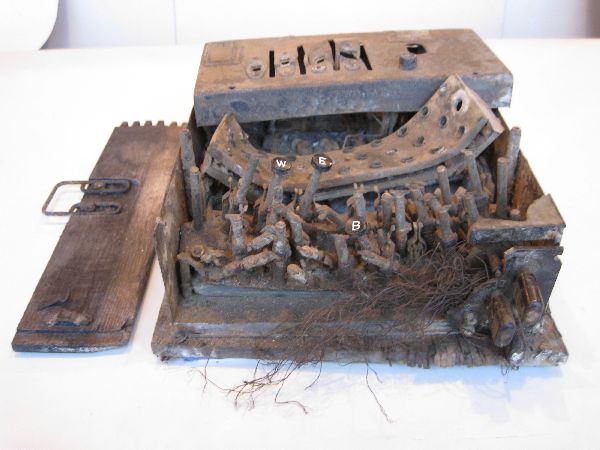
Again, comparison to an undamaged light panel clarifies the extent of the damage:

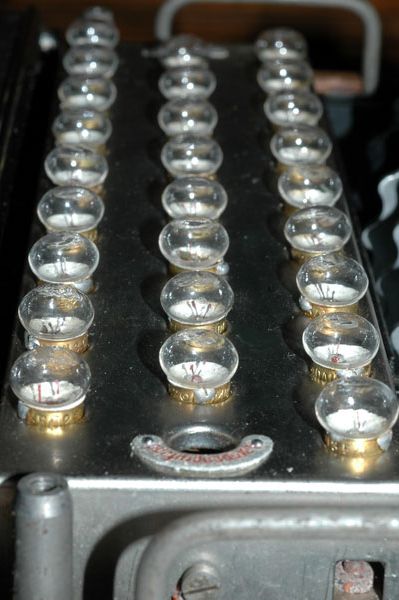
FINDING THE MURDER WEAPON
It is clear from these photographs that the left side of the lamp panel is more depressed than the right indicating that a greater force was applied to the left side than to the right.
This observation allows us to tentatively eliminate a kick or stomp with a
boot as the cause of death because a boot would have produced a more even
depression and a more curved center. It was common for the German soldiers to
try to damage Enigmas at the last moment before they were captured by
delivering a strong kick to the machine and indeed the damage to the front of
the Enigma where the plugboard or steckerboard was located may have been
caused by a kick.
The tools that German soldiers had available to them in the field were
limited. They did not typically have hammers or heavy weights that they could
use to smash something. The one tool that virtually all soldiers had with
them, however, was their rifle.
Most soldiers had ready access to their Mauser bolt-action rifles. It would
have been natural for them to reach for their rifle even in times of stress
and to use it in whatever way was required. To quickly damage an Enigma, it
is logical that a soidlier might have pounded the butt end of his rifle into
the top of the Enigma. Any other way of damaging it with his rifle would have
been less effective and perhaps dangerous to the operation of the rifle or
dangerous to the soldier.
On the assumption that a Mauser rifle might have been used to damage this Enigma, a typical WW-II German Mauser was borrowed from historian and collector Charles Woolley and placed in position directly over the depression in the Enigma light panel.
It is obvious that the butt end of the Mauser rifle fits precisely into the
depression in the lamp panel. This shows that it was most likely the direct
cause of the death of the Enigma.
The left part of the butt of the Mauser is directly in line with the heavy
barrel and action of the rifle and thus would have exerted more downward force
than the right part of the wooden stock. This would account for the
observation that the left side of the lamp panel is more depressed than the
right side.
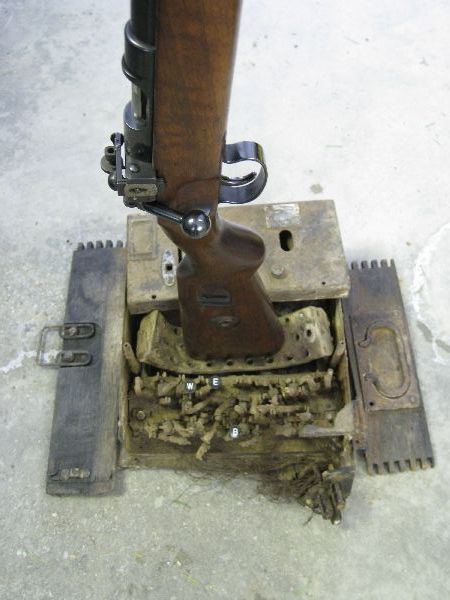
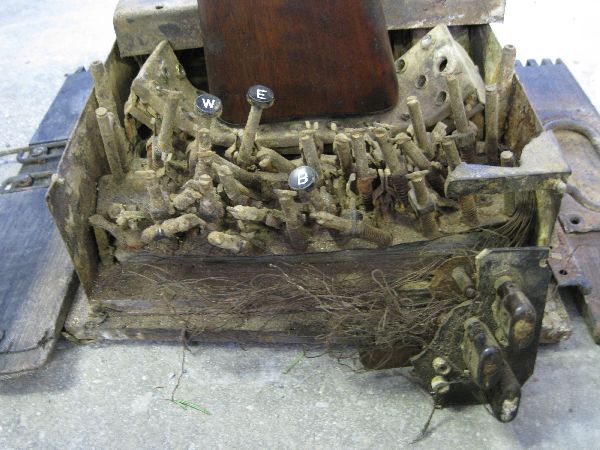
The pattern of crushing damage to the light bulbs in their sockets suports the
conclusion that the damage was caused by a rifle butt. Notice the crushed and
flattened light bulb and socket directly under the spot where the major blow
was administed in the left photograph and the slightly less damaged light
bulbs and sockets elsewhere in the light panel as shown in the right
photograph.

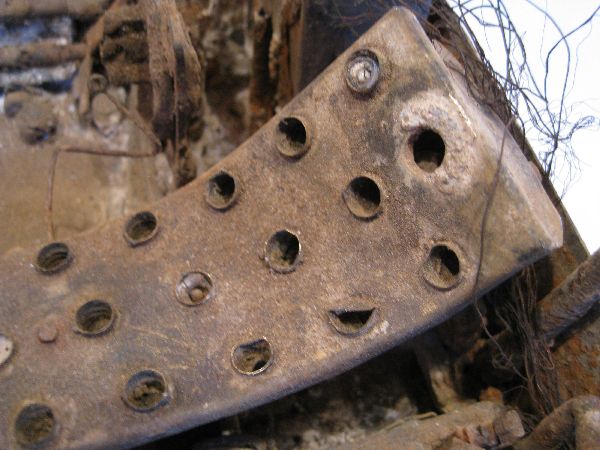
LOCATING ADDITIONAL DAMAGE
The Enigma shows many other signs of major damage. As with any autopsy, these must all be identified and described.DAMAGE TO THE KEYBOARD
Most of the keyboard has been destroyed but the pattern of destruction does not give a clear indication as to how it was destroyed. Since the keys are rather strongly supported by a metal plate underneath them, it is likely that the butt of the Mauser was used instead of a kick from a boot because it can produce considerably more force. Only a few of the keytops survived what were probably multiple impacts. The pattern of the surviving keytops does not give any clear clues as to the source of the damage. The following photographs show closer views of the damage to the keyboard. Again, a comparison with an undamaged keyboard is helpful in assessing the damage.


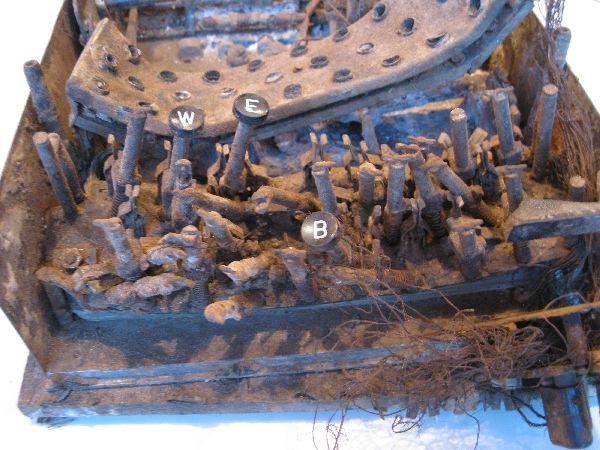

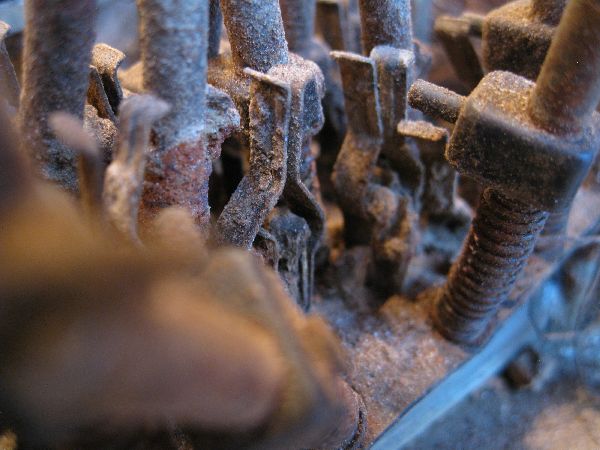
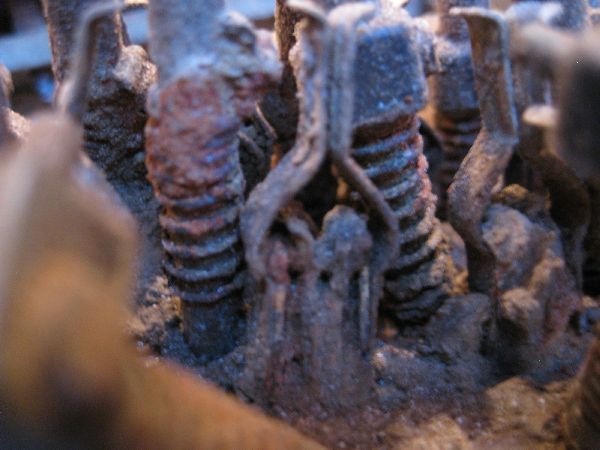
DAMAGE TO THE PLUGBOARD
Much of the plugboard has been smashed and many of the delicate connectors were buried in the mud around and near the Enigma. The damage can be seen in the following photographs. Again, comparison with an undamaged plugboard helps evaluate the damage.
Very little is left of the plugboard. Since it is made of brittle bakelite,
the damage could have been inflicted by a kick with a heavy boot or by more
strikes with the butt of a rifle stock.
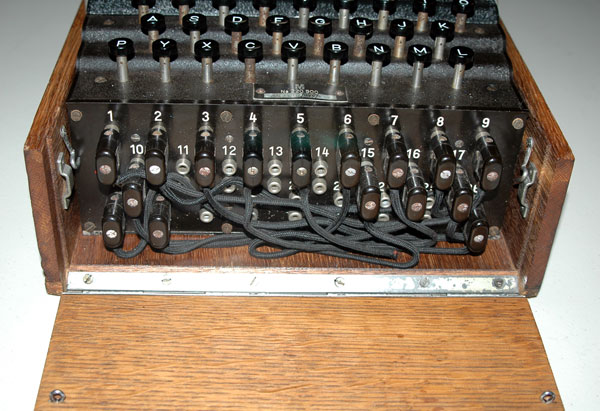
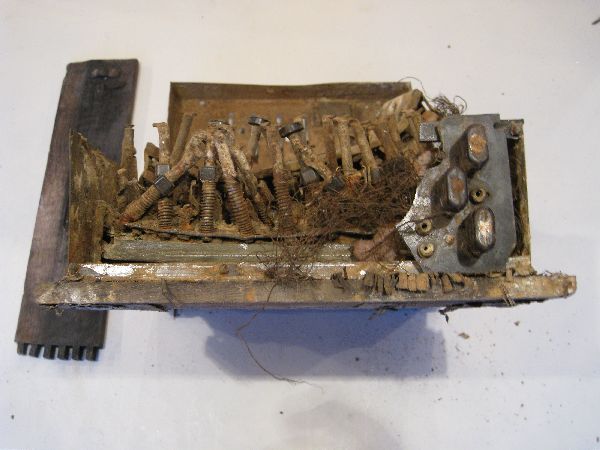
Notice the total absence of insulation on all of the jumper cable (stecker) wires and all of the wiring behind the plugboard. some kind of organism in the lake water must have attacked this insulation and removed it completely so that no insulated wires remain throughout the Enigma.
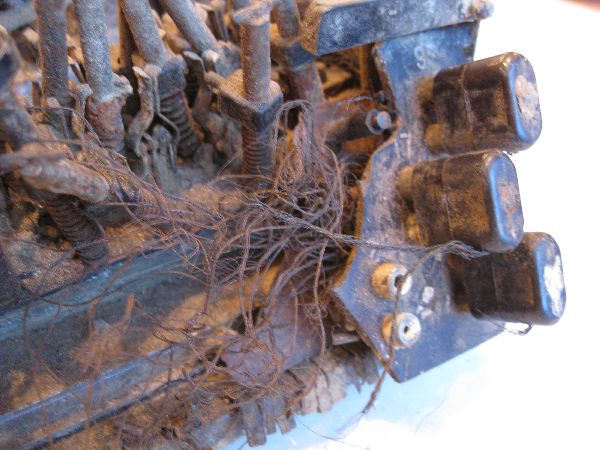
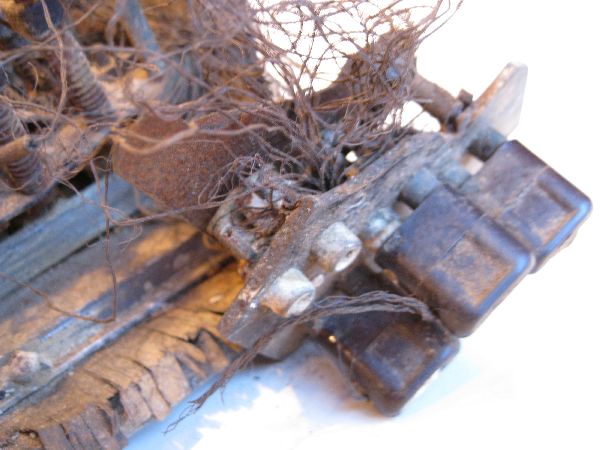
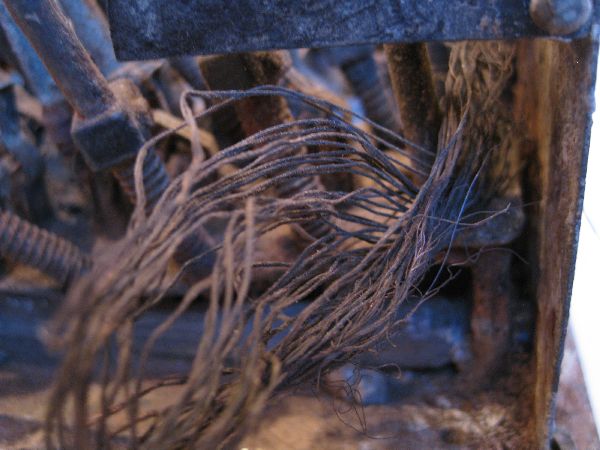
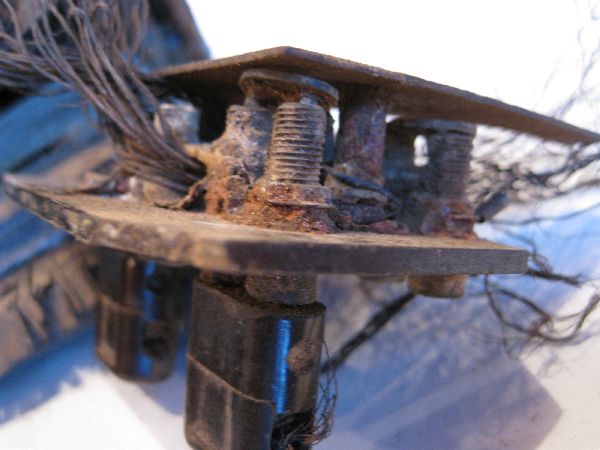
The stecker plugs show a total absence of insulation on all of their wires.
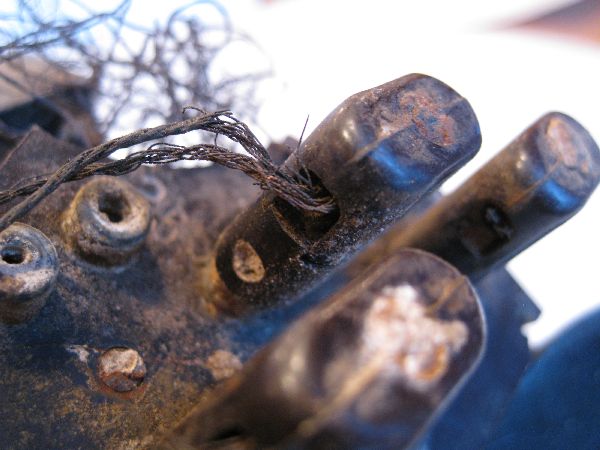

Some of the springs that hold the shorting bars accross the sockets have deteriorated and disappeared.

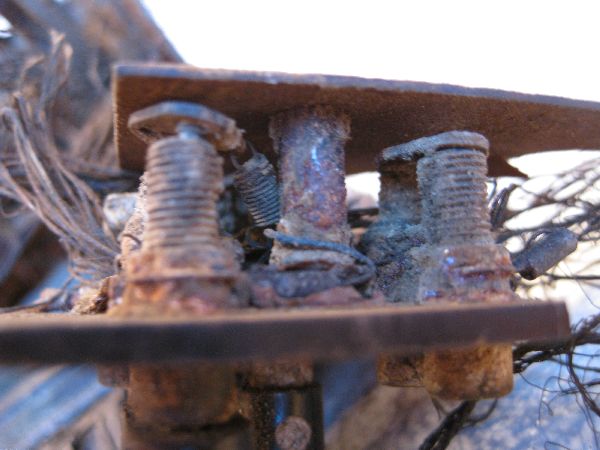
DAMAGE TO THE ROTOR MECHANISM AND ROTORS
Starting with a view of an undamaged rotor mechanism allows comparison with the damaged machine and provides some information about how the damage may have been produced.
In order to get at the rotors and to destroy them the metal cover that lies
over the rotors must be hinged back and out of the way. This procedure took
some time and thought so it is again clear that the destruction of this Enigma
was not done in a momentary act but that it was thought out and carried out
with some care.
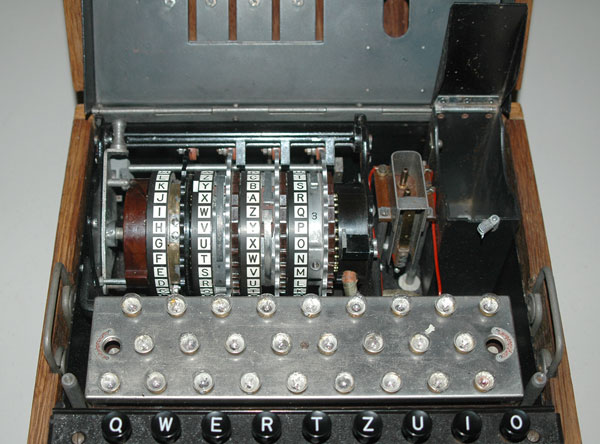
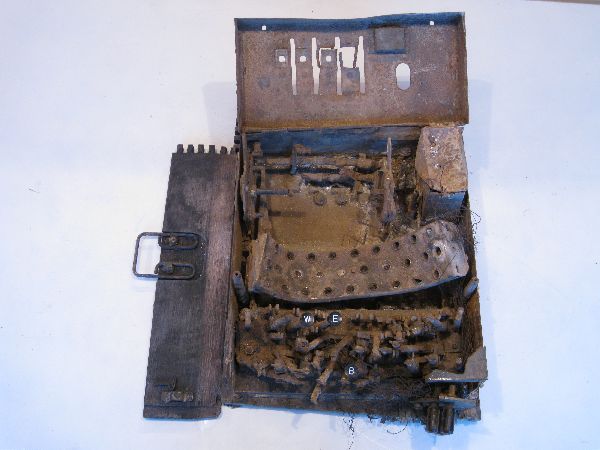
The metal rotor cover received an impact from it's underside that broke part of the rightmost rotor window and forced it and nearby areas outward. The Right picture shows that the entire rotor mechanism was hit one or more times. These blows destroyed the rotors and damaged the rotor drive mechanisms.

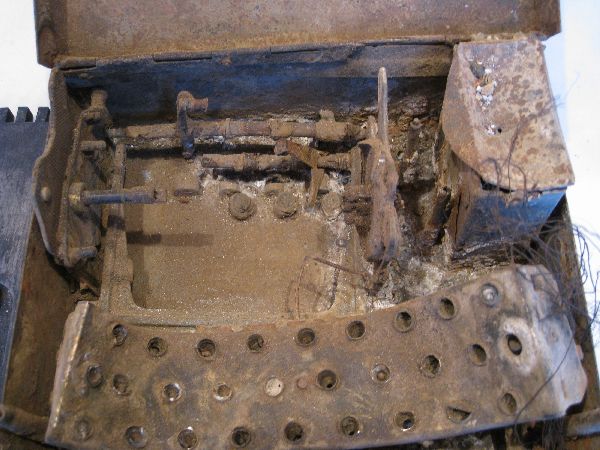
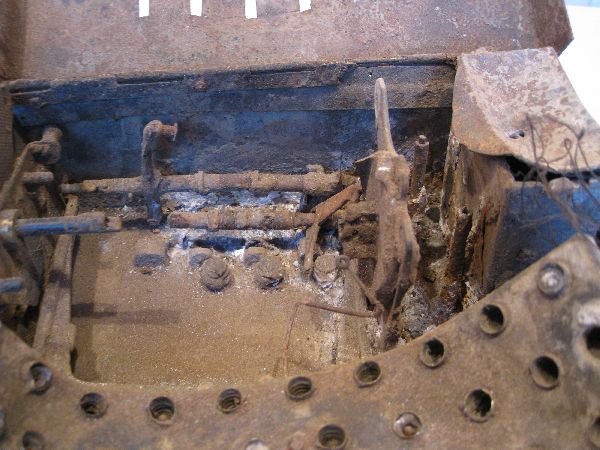
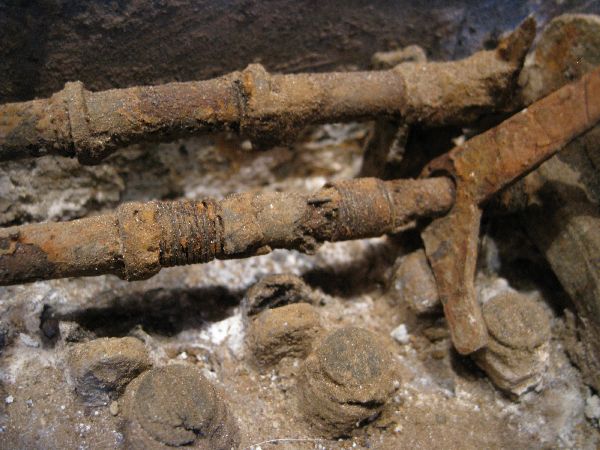
The rotor unlocking lever over to the left where the reflector was mounted was left relatively undamaged. However, the input wheel to the right of the rotors was shattered by a blow from a heavy object leaving just the metal bushing.
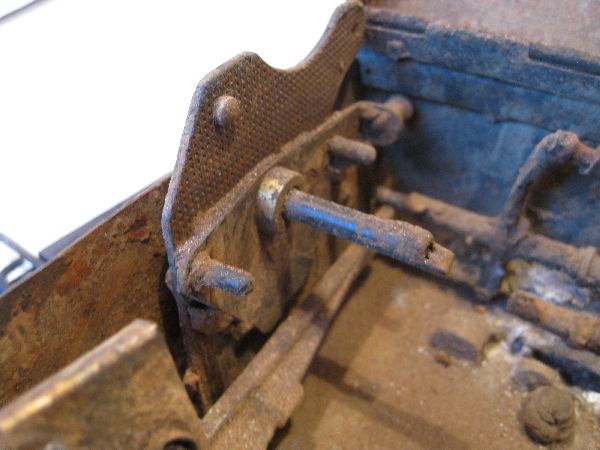
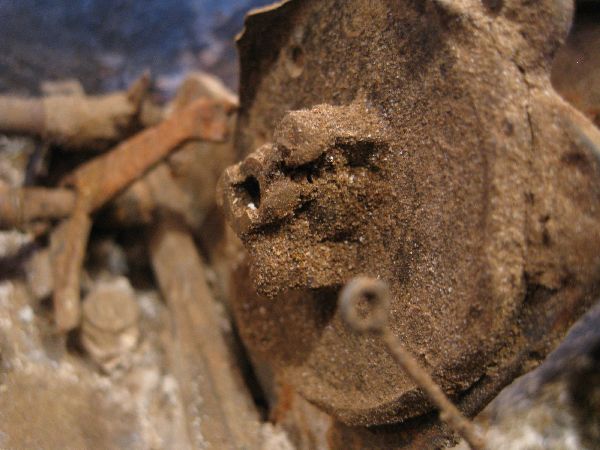
The rotors themselves have been smashed and only a few pieces have been recovered from the crime scene. Notice that all of the internal wires connecting all of the contacts on one side of a rotor over to the other side have had all of their insulation totally removed by some organism or some chemical in the lake water.
Enough of one rotor was recovered to determine the serial number of the rotor
and most likely of the Enigma itself. As you can see, the serial number is:
M10015. The "M" identifies it as a marine Enigma.
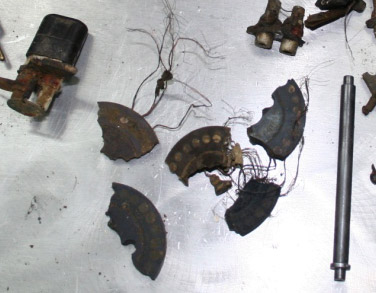
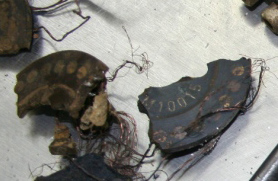
DAMAGE TO THE BATTERY BOX
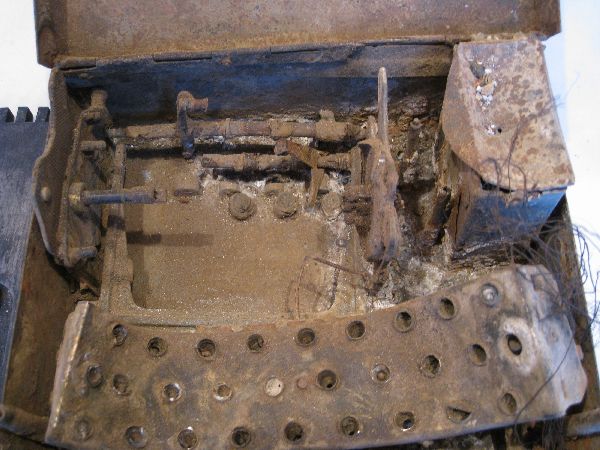
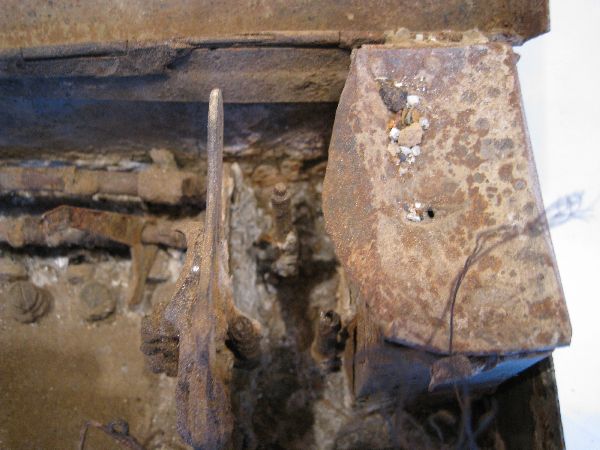
A close look at the top of the battery box shows two holes at the bottom of an indentation. Although it is possible that these holes were made by a bullet fired at the battery box, it seems more likely that they were made by a glancing blow from some metal part of a rifle.
Little additional information can be obtained by looking at the bottom of
the lid of the battery box but it is shown on the right.
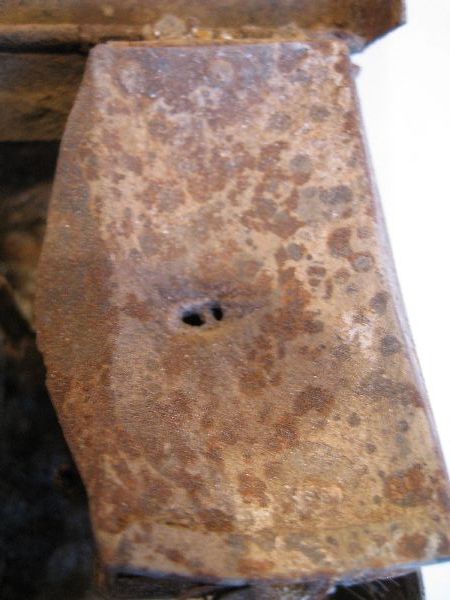
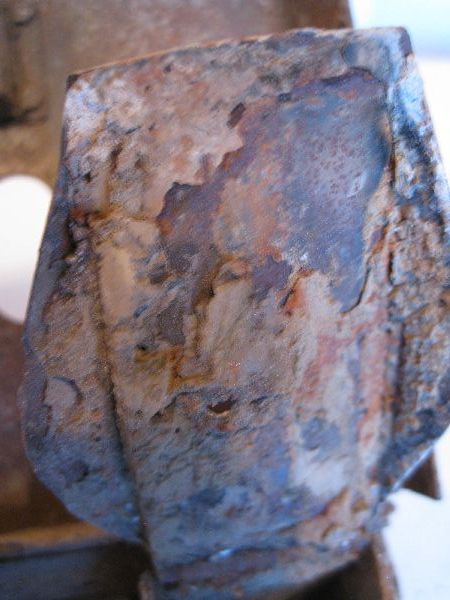
DAMAGE TO THE CASE
The metal case of the Enigma sustained no impact damage. The only visible marks are those left by the mud and the water which produced some rusting and corrosion.
Although only two pieces of the sides of the wooden case remain, they too have
sustained no direct impact damage and only show some rusting and corrosion of
their metal fittings.
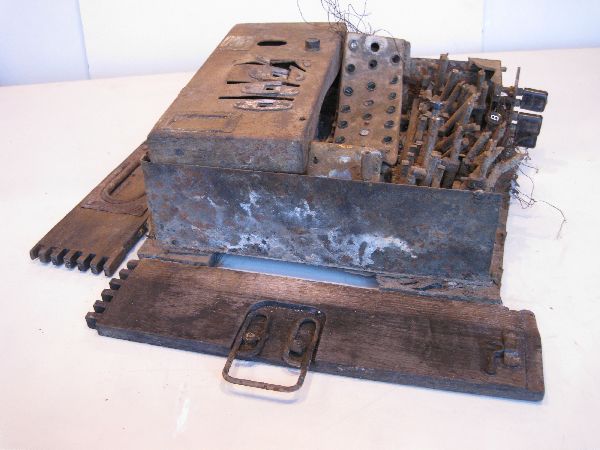
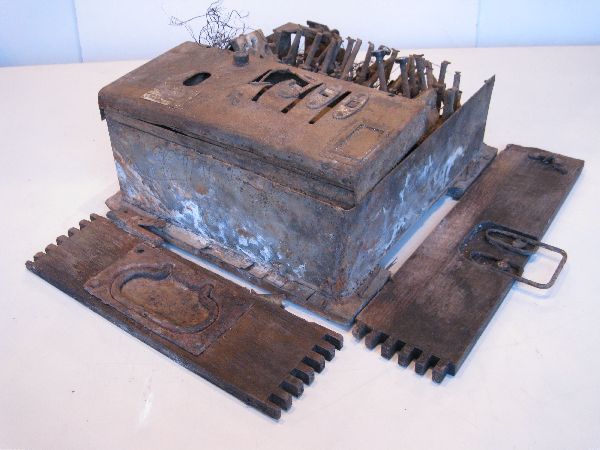
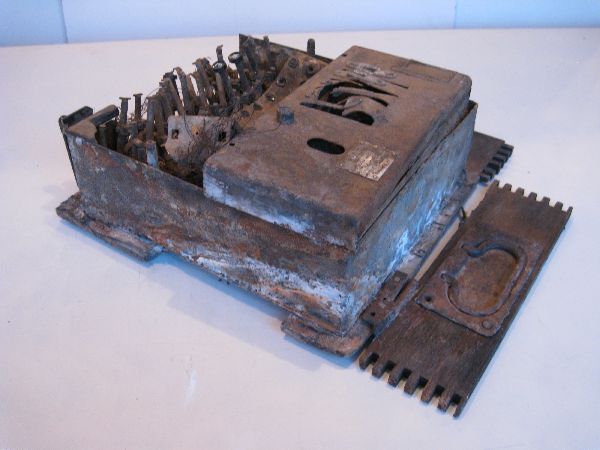
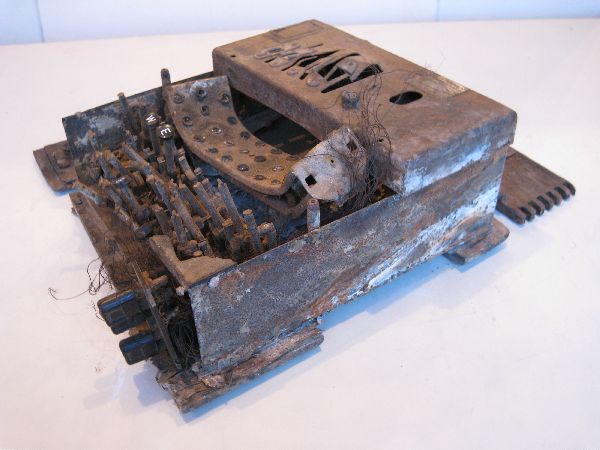
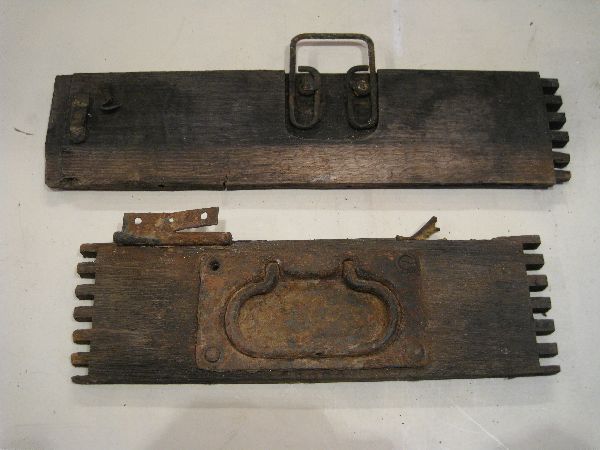

The bottom of the Enigma shows considerable disintegration of the wooden case and delamination of the veneer finish on the wood. Considering that the machine has been immersed in water for over 65 years it is surprising that more disintegration of the case is not present.

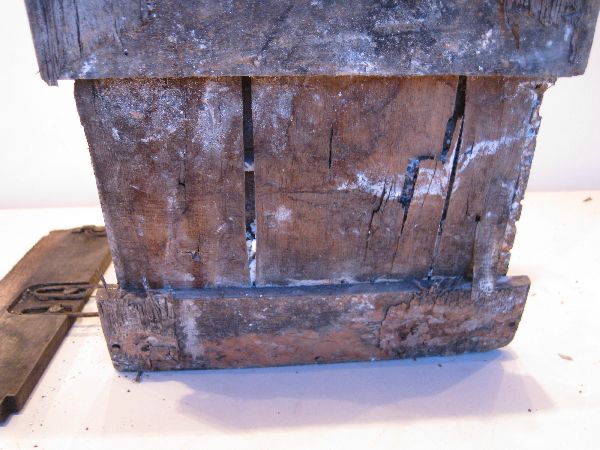
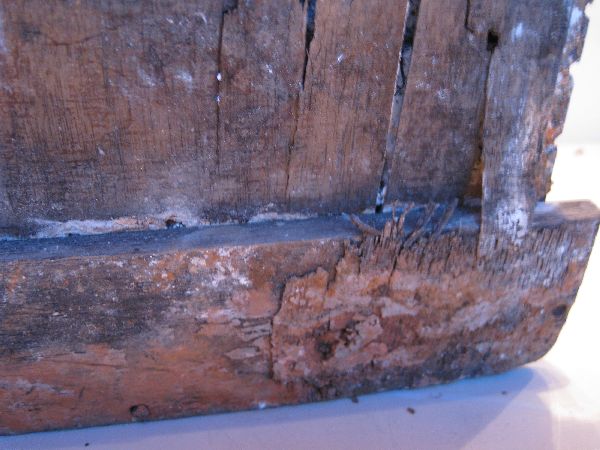
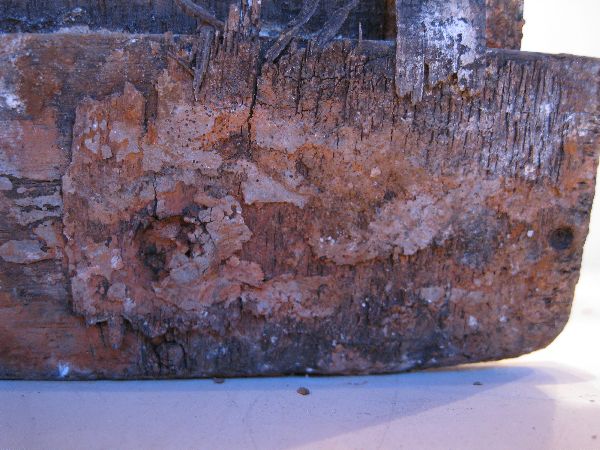
SUMMARY AND CONCLUSIONS
A careful analysis of the damage sustained by this Enigma reveals that it was destroyed by multiple impacts from a heavy object or heavy objects. the shape of the light panel damage suggests strongly that it was produced by a blow from the butt of a WW-II German Mauser rifle.
The most extensive damage was found on the light panel, the keyboard, the
plugboard, and the rotor mechanism. The case was undamaged.
The pattern and extent of the damage indicates that the machine was destroyed
by a person who knew the most important parts of the machine and who set about
to destroy each of them.
Some organism or chemical in the lake water was responsible for removing all
of the insulation from every wire in the entire Enigma. It would be useful to
try to determine precisely what removed the insulation.
One of the most important unanswered questions is why a German WW-II Navy
Enigma and experimental torpedo were dumped in a lake that lies a considerable
distance from the sea.
Additional diving expeditions are planned and they will hopefully retrieve
more Enigma parts and possibly provide more information that will fill in the
questions posed by the recovery of this Enigma.
The http://EnigmaMuseum.com or:
The http://w1tp.com/enigma museum.
{ ENIGMA MACHINES and PHOTOGRAPHS WANTED; Museum Buying for Cash. }
{ Information & Repairs available: Contact Email at bottom of page. }
* * THE STORY OF THE ENIGMA CD: History, Technology, and
Deciphering (NEW 4th Edition) (Details, Table of Contents & Ordering
Information)
This newly expanded CD is a complete cipher machine library. It has twice the
material in the 3rd edition. It tells the complete story of the ENIGMA !
Thousands of pictures, books, Enigma simulator programs, construction
projects, other cipher machines, realistic videos... and much more. $15. ** (Updates & Corrections)
* * NEW BOOK: INSIDE ENIGMA: Inside the German ENIGMA
and other Historic Cipher Machines
(Details, Table of Contents & Ordering Information)
NOTE: WE ARE AM ALWAYS LOOKING TO BUY, TRADE, OR PHOTOGRAPH VERY UNUSUAL
ENIGMA-RELATED ITEMS.
Thomas B. Perera Ph. D.
COPYRIGHT NOTICE: (Copyright (c) 2013: Prof. Tom Perera Ph. D.)
This new book contains 208 pages and over 500 pictures that exlain the
history and workings of the ENGIMA and other cipher machines including the
Russian Fialka. $20. ** (Updates &
Corrections)
CONTACT INFORMATION
Professor Emeritus: Montclair State University
Curator: EnigmaMuseum.com
Internet On-Line ENIGMA Museum: http://EnigmaMuseum.com or
http://w1tp.com/enigma
I ask you to type my email address as
follows with no spaces between words:)
Internet On-Line Telegraph & Scientific Instrument Cyber-Museum:
http://w1tp.com
Although all the pictures and text are copyrighted, you may use any of them
for your own personal applications including public lectures and
demonstrations, publications and websites as long as you mention the
www.EnigmaMuseum.com or w1tp.com/enigma Museum. If you plan to offer them for sale to the public
in any form, you must email me for permission which I will generally grant as
long as you mention my museums: http://EnigmaMuseum.com or http://w1tp.com/enigma. My email address is
given at the bottom of this page. Some of the material may require contacting
other copyright owners for commercial use and I will inform you by email.
Please also see the disclaimer of warranty.